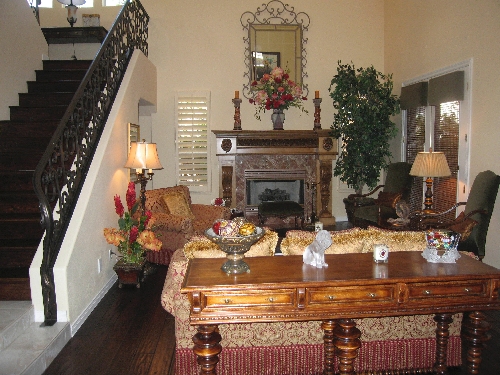Traditional design takes on relaxed style

Dinner that evening in my client’s newly designed Tuscan dining room was nothing less than wonderful. The company was great, the food superb and, as we sat comfortably around the custom plank dining table in those grand carved chairs, glass after glass was raised in celebratory toasts to their new “old” home.
Looking up at the mural of the Italian countryside almost gave me the feeling of actually being in some beautiful Tuscan home laughing and relaxing with friends. I knew then and there that my clients would like nothing better than to continue that kind of graceful Old World charm in their great room, which was just crying out to be saved from its present state of bland contemporary punctuated here and there by decorative touches of this and that.
We settled into that room for coffee and a nightcap and, in reality, we had already begun the transformation of that space with the recent addition of a fabulous new fireplace mantle. Instinctively my clients and I knew that from that point on there’d be no turning back in our plan to create the kind of home they’d always dreamed of having. They were ready for a change and I began to share my vision with them of what traditional design looks like when filtered through today’s modern lifestyle.
To begin with, I pointed out that the key to a successful design is how the elements in the room are put together. This begins with a focal point, such as their fireplace mantle, for example. And with that in mind, everything else can be placed in relation to it. I stressed that, in traditional design, symmetry is an important element so that the space feels balanced, such as two chairs placed on either side of a table. As for their sofa, we’d move it from the wall to the center of the room facing the fireplace, which is not only functional but pretty much expected with the traditional look.
Our goal would be in lockstep with a definite and growing movement to bring traditional design into a fresher and more relaxed state even though elegance and history are still very much defining elements of this style. I further explained that even though traditional is evolving and changing, its hallmark characteristics are still fine woodworking, craftsmanship and graceful lines.
My clients seemed very interested in what I had to say, despite the late hour, so I continued explaining that in this new and more relaxed style of traditional decorating the fabric colors and textures may seem less formal than they might be expecting – but still, I assured them, they’d be no less elegant. The wood furniture and finishes that I’d be choosing for them would be mixed and matched less strictly than in the past, as would their fabrics. I’d be using some old and some new, side by side, with complete confidence in being able to achieve our design goals.
With that said, I already knew that I wanted to use natural woven window shades for their French doors in order to create a very tailored look. But, I’d crown them with traditional cornices covered in the green velvet I’d use on the two bergère chairs (after refinishing them in a wood tone, of course). Furthermore, I’d enhance them with the same gold braiding I’d use as pillow trims on the sofa and matching club chair. I’d choose a key fabric for the sofa and club chair and them mix some other patterns from the same color family. I’d layer pattern and texture to give more interest to the space along with a variety of fringe, tassels and trim. What fun! And one of the reasons I’ve grown so fond of modern traditional design.
My clients were more than enthusiastic by this point so I thought it was a good time to mention that the carpeting would have to go and be replaced with a hard floor. A dark, wide-plank distressed look would be best for their home. They loved that idea and my further suggestion of a colorful Persian rug(s) to bring warmth and anchor the space was embraced by them as well.
We were off and running it seemed, so I thought to myself, “Why stop now when everything was going so well?” It was at that point, no doubt giddy from the late hour and the exciting design plans we were sharing, that we seemed to shout out the same idea all at once. The wood railings would have to go and be replaced with classic iron in a scroll pattern was the unanimous declaration and, as a designer, I was grinning from ear to ear like some Cheshire cat.
In a word, traditional design today isn’t very stodgy anymore – furniture is less fussy than in the past and often more comfortable as well. Balance is still a key factor and bright bold colors can be used just as long as they’re offset by neutral tones; a relaxed elegance can be achieved by mixing reproductions, antiques and even some contemporary pieces.
Remember to keep it simple, keep it comfortable, keep it interesting, but also keep it fun!
Stephen Leon is a licensed interior designer and president of Soleil Design International; he has been designing and manufacturing custom furniture and cabinetry for more than 25 years. He has served on the board of directors of the Central California/Nevada Chapter of the American Society of Interior Designers and is a certified professional in green residential design. Questions can be sent to stephen@soleildesigninter
national.com.